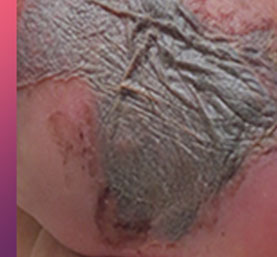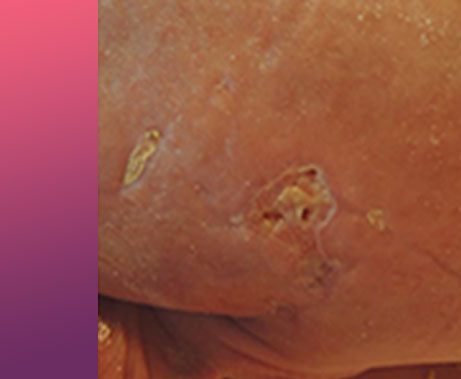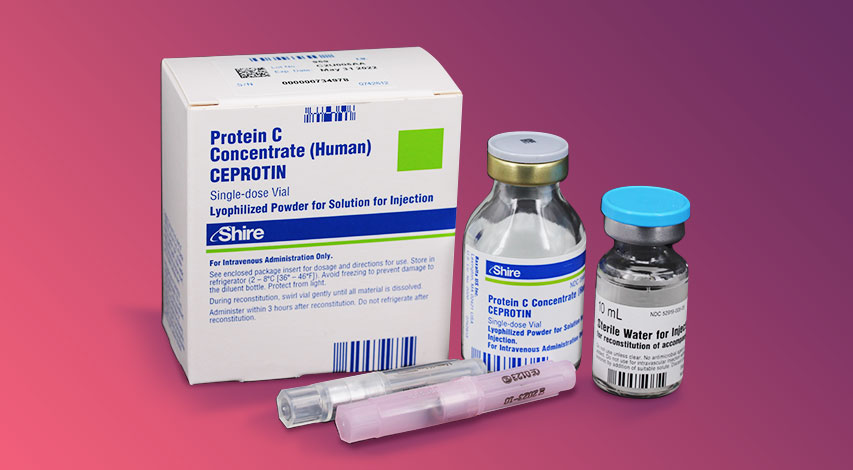CEPROTIN [Protein C Concentrate (Human)] is effective in treating and preventing purpura fulminans and venous thrombosis in patients with severe congenital protein C deficiency.1,2
Learn more about the prospective, multi-center, open-label study that demonstrated the efficacy and safety of protein C concentrate.2
CEPROTIN is indicated for neonates, pediatric and adult patients with severe congenital Protein C deficiency for the prevention and treatment of venous thrombosis and purpura fulminans.1
Neonatal Case Study of Treatment of Purpura Fulminans Over 28 Days with CEPROTIN

+24h
rapid progression of purpura fulminans: appearance of the skin on the left thigh at 24 hours of age based on a case study3

+8D
improvement of skin changes on day of life 8 after treatment with CEPROTIN based on a case study3

+28D
Possible skin improvement that could be observed over 28 days of treatment with CEPROTIN based on a case study3
Photos courtesy of Bubl B, Gysling Hagemann K, Dallavès F, Bartenstein A, Nelle M, Neonatal Purpura Fulminans, Swiss Society of Neonatology, University Children’s Hospital of Berne, Switzerland.
Warnings and Precautions
Hypersensivity: CEPROTIN may contain trace amounts of mouse protein and/or heparin as a result of the manufacturing process. Allergic reactions to mouse protein and/or heparin cannot be ruled out. If symptoms of hypersensitivity/allergic reaction occur, discontinue the injection/infusion. In case of anaphylactic shock, the current medical standards for treatment are to be observed.
Transmission of infectious agents: Because CEPROTIN is made from human plasma, it may carry a risk of transmitting infectious agents, e.g. viruses, the variant Creutzfeldt-Jakob disease (vCJD) agent, and theoretically, the Creutzfeld-Jakob disease (CJD) agent.
Bleeding episodes: Several bleeding episodes have been observed in clinical studies. Concurrent anticoagulant medication may have been responsible for these bleeding episodes. However, it cannot be completely ruled out that the administration of CEPROTIN further contributed to these bleeding events. Simultaneous administration of CEPROTIN and tissue plasminogen activator (tPA) may further increase the risk of bleeding from tPA.
Heparin-induced thrombocytopenia (HIT): CEPROTIN contains trace amounts of heparin which may lead to HIT, which can be associated with a rapid decrease of the number of thombocytes. If HIT is suspected, determine the platelet count immediately and consider discontinuation of CEPROTIN.
Low sodium diet/Renal impairment: Patients on a low sodium diet or who have renal impairment should be informed that the quantity of sodium in the maximum daily dose of CEPROTIN exceeds 200 mg. Monitor patients with renal impairment closely for sodium overload.
Adverse Reactions
Common adverse reactions related to CEPROTIN observed in clinical trials were hypersensitivity or allergic reactions: lightheadedness, itching and rash.
INDICATION
CEPROTIN [Protein C Concentrate (Human)] is indicated for neonates, pediatric and adult patients with severe congenital Protein C deficiency for the prevention and treatment of venous thrombosis and purpura fulminans.
Please click for Full Prescribing Information.
References:
-
CEPROTIN [Protein C Concentrate (Human)] Prescribing information. Lexington, MA: Baxalta US Inc.
-
Manco-Johnson MJ, et al. Efficacy and safety of protein C concentrate to treat purpura fulminans and thromboembolic events in severe congenital protein C deficiency. Thromb Haemost. 2016;116:56-68.
-
Bubl B, Gysling Hagemann K, Dallavès F, Bartensein A, Nelle M, Neonatal Purpura Fulminans, Swiss Society of Neonatology, University Children’s Hospital of Berne, Switzerland.


